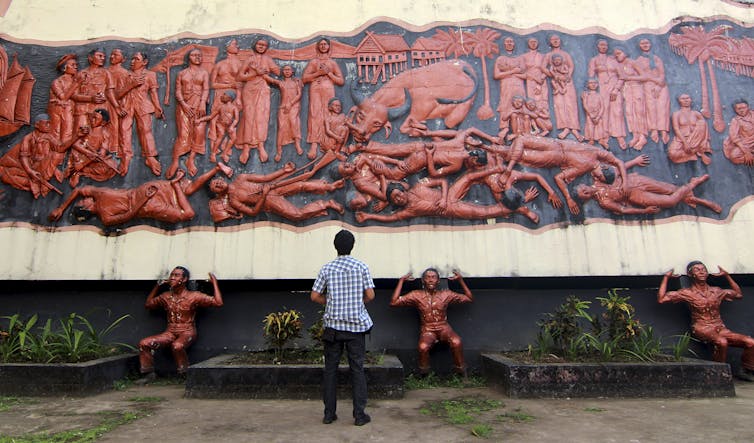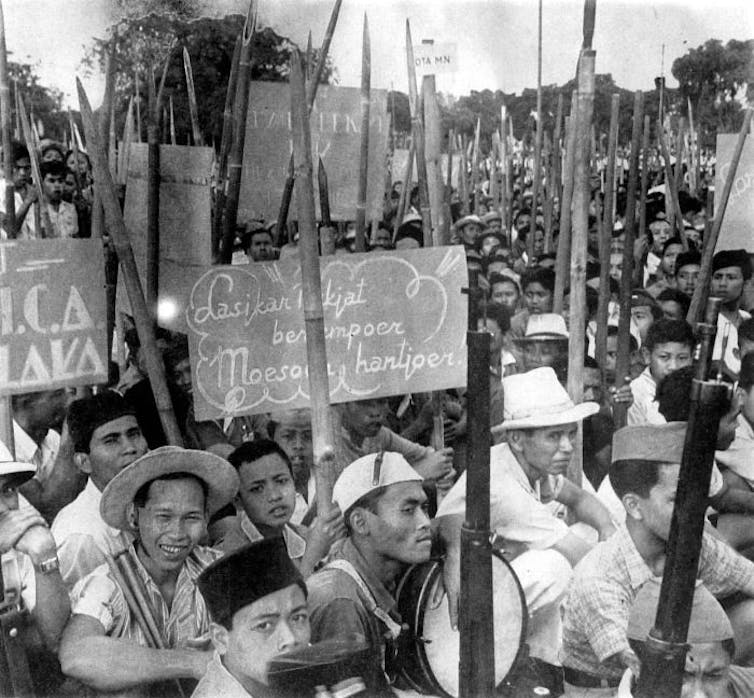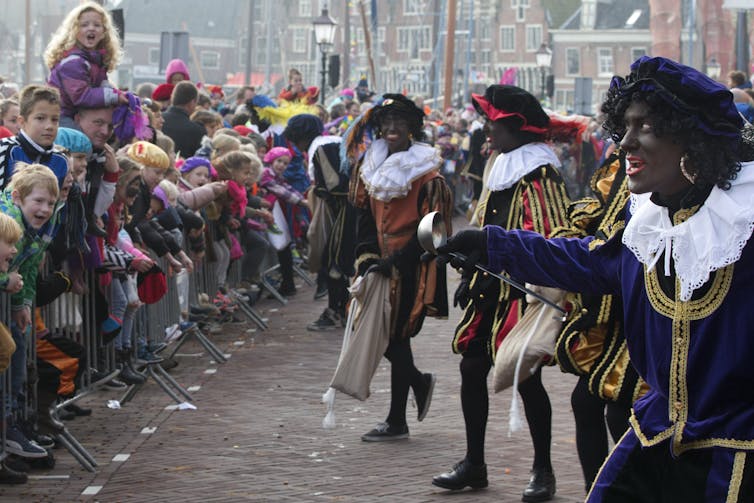Dutch Memorial Day: Erasing people after death
- Written by Annemarie Toebosch, Director of Dutch and Flemish Studies, University of Michigan
As the anniversary of Indonesian independence from the Netherlands approaches, a close look reveals a Dutch narrative that erases people along racial lines.
Indonesia declared independence from the Netherlands[1] on Aug. 17, 1945. This followed 350 years of Dutch East India Company control[2] and Dutch state rule, as well as Japanese occupation during WWII.
After the declaration, the Netherlands waged a war[3] to re-establish colonial control over Indonesia. The war, whose dead included Indonesians killed by summary execution, cost an estimated 300,000 Indonesian lives compared with around 6,000 casualties on the Dutch side[4].
In Indonesia, national identity has been built around anti-colonial sentiment, and the history of Dutch violence is taught and discussed. There was much Indonesian attention for a court-ordered Dutch apology in 2011[5] for the 1947 massacres in Rawagede and for execution pictures that surfaced in 2012[6]. Indonesian violence toward the Dutch is emphasized less, but not ignored[7].
How does the Netherlands deal with this history?
As a social scientist[8] and director of Dutch and Flemish studies at the University of Michigan, I ask this question in my writing and teaching about issues of inclusion in the Dutch-language area.
The answer to that question: The Netherlands ignores the sacrifices of Indonesians. Here’s how and why.
Paid independence
The Indonesian War of Independence of 1945-1949 ended with the signing of an internationally mediated independence agreement requiring Indonesia to take over the Dutch East India government’s debt, effectively paying the Netherlands 4.3 billion guilders[9] for its independence[10]. Payments continued until 2002[11].
A Western European nation thus rebuilt itself after World War II with Marshall Plan loans[12] from the United States, plus a comparable amount of money from Indonesia, which was itself recovering from the war.
The struggle for historic justice for Indonesia continues today. One expression of that struggle unfolds on Dutch Memorial Day, May 4[13], the day when the Netherlands remembers its dead from World War II and after. The day involves a ceremony with two minutes of national silence and the laying of wreaths by the Dutch king and queen.
The Indonesians who fought against the Dutch and were killed in the ‘45-'49 war are not commemorated in this ceremony, despite the Dutch officially considering them Dutch at the time.
 Relief sculpture in Indonesia depicting mass killings of Indonesians committed by the Dutch military during the Indonesian independence war.
AP Photo/Masyudi S. Firmansyah
Relief sculpture in Indonesia depicting mass killings of Indonesians committed by the Dutch military during the Indonesian independence war.
AP Photo/Masyudi S. Firmansyah
An exclusive Memorial Day
Dutch Memorial Day is no stranger to protests against exclusion[14], and the Indonesian victims of the war are not the only ones who have been ignored on this day.
It took decades, for example, for Dutch Holocaust victims to be remembered[15].
Today a Dutch movement called “No May 4 For Me[16]” protests the exclusion of Indonesian casualties from remembrance while their killers are remembered. Among the killers were former Dutch Nazis, who were sent to Indonesia after World War II to fight for Holland in the War for Independence[17].
Recognizing Indonesian independence
So who is, and who is not, commemorated on Dutch Memorial Day?
The key to the answer is this: The Netherlands does not officially recognize Indonesia’s 1945 independence[18] – it recognizes the 1949 date of the sovereignty agreement[19] instead.
Here’s why the Netherlands cannot recognize Indonesia’s 1945 independence: If the Netherlands recognized that date, that would mean that the country had attacked a sovereign nation after World War II with the purpose of recolonizing it. And then the massacres, euphemistically referred to in the Netherlands as the “police actions,” would not be “police actions” but war crimes[20], as explained in an upcoming book by Ady Setyawan and Marjolein Van Pagee.
 Indonesian independence fighters in 1945. Most are armed with bamboo spears.
Tropenmuseum/National Museum of World Cultures., CC BY[21][22]
Indonesian independence fighters in 1945. Most are armed with bamboo spears.
Tropenmuseum/National Museum of World Cultures., CC BY[21][22]
Military action
According to the official Dutch story, however, Indonesia was “Dutch” during the “police actions”[23], and thus killing your own people is not a war crime but, rather, law enforcement gone wrong.
Except that law enforcement in the “police actions” were not police officers but soldiers serving in the Dutch army[24].
The publication “De Doden Tellen[25]” (“Counting the Dead”), issued by the government-appointed national Memorial Day committee, betrays the inconsistencies of the official story. It cites the conflict as “police actions” while simultaneously using language of military “conquest.”
“During the so called police actions, the Netherlands conquers areas and declares them as Dutch territory once again[26],” the publication says.
Apartheid
The Netherlands wants to count the people it has killed as its own, so as not to have committed war crimes, while at the same time not commemorating their deaths.
What lies beneath the surface of the exclusion is segregation on the basis of race.
Dutch colonialism did not grant citizenship to indigenous Indonesians[27]. Now, 70 years later, colonial apartheid policies that separate, disadvantage and denigrate one race in favor of another are applied after death, on Dutch Memorial Day. On a day that commemorates civilian casualties of war, Indonesian civilian casualties are not commemorated because they had no citizenship under colonial rule.
The chair of the official government national Memorial Day Committee, Gerdi Verbeet, admits as much when she says that “those who had no Dutch passport are not remembered at the moment[28].”
There is further evidence of a racial exclusion policy on Dutch Memorial Day: Indonesian victims of World War II are also not commemorated.
Although the number is not verified, civilian casualties from World War II in Indonesia are commonly estimated at 4 million[29]. The official document[30] that counts the dead to be commemorated on Dutch Memorial Day lists around 20,000, a stunning discrepancy. The way that the Dutch come up with such a wildly different number is because they exclude all indigenous people. Millions of people are thus erased on Dutch Memorial Day.
Counting the dead
Dutch Memorial Day is then a story about the value of human life, about who counts, who doesn’t and who gets to decide.
Four million brown civilian casualties of World War II don’t count; 300,000 brown victims of the “police actions” don’t count.
And in a sad twist in this tale, exactly one group of brown people does count: the fallen Indonesian soldiers, most of them Moluccans[31], who fought on the side of the Netherlands during the recolonization war. They are the victims-made-perpetrators by a colonial oppressor after a centuries-long history of exploitation.
Colonial thinking as a form of racial supremacy is never far away in the Netherlands. In Indonesia, it took the form of an assumed right to enslave people[32], kill them and take their land for profit. Afro-Surinamese Dutch educator and writer Gloria Wekker, in her groundbreaking book “White Innocence[33],” analyzes it as the racial exceptionalism that paved the way for white Dutch culture’s blindness to the many forms of racism today.
Dutch racism is evident in the fact that the country has the worst employment outcomes[34] for people of color in Europe other than Sweden. In another example, the second-largest political party, the Party for Freedom, puts out dehumanizing campaign ads[35] in both Dutch and English that target the country’s Muslims, saying their religion equals “discrimination,” “injustice” and “honor killing,” among other attributes. A legislator warns of the dangers of mixing Dutch and non-Dutch blood[36]. Just this past year, Surinamese- and Antillean-Dutch were barred from attending a May 4 memorial[37] if they spoke publicly of the history of Dutch slavery in the Dutch slave colonies of their heritage.
 The Dutch version of Santa Claus, Sinterklaas, or St. Nicholas, and his blackface sidekicks ‘Zwarte Piet’ or ‘Black Pete.’
AP/Peter Dejong
The Dutch version of Santa Claus, Sinterklaas, or St. Nicholas, and his blackface sidekicks ‘Zwarte Piet’ or ‘Black Pete.’
AP/Peter Dejong
The most widely known throwback to colonialism and Dutch slavery[38] comes each year in the form of “Black Petes,” the caricatured black helpers of St. Nicholas on the nation’s most important tradition[39].
Shared memory
Elizabeth Eckford[40], one of the first African-American students in a desegregated school, said that[41] “true reconciliation can occur only when we honestly acknowledge our painful but shared past.”
In the Netherlands, this message is reflected in the voices of the “No May 4 For Me” protesters, who want their dead counted but instead find a culture blind to its own guilt and unwilling to create a shared memory.
Building a shared memory could start today, with the Dutch recognition of Indonesian Independence Day and the commemoration of Indonesian casualties of war.
References
- ^ declared independence from the Netherlands (www.britannica.com)
- ^ Dutch East India Company control (www.britannica.com)
- ^ the Netherlands waged a war (www.newworldencyclopedia.org)
- ^ on the Dutch side (www.singeluitgeverijen.nl)
- ^ Dutch apology in 2011 (www.bbc.com)
- ^ execution pictures that surfaced in 2012 (www.tandfonline.com)
- ^ but not ignored (historibersama.com)
- ^ As a social scientist (lsa.umich.edu)
- ^ paying the Netherlands 4.3 billion guilders (www.britannica.com)
- ^ for its independence (www.groene.nl)
- ^ continued until 2002 (www.waterkant.net)
- ^ Marshall Plan loans (nl.usembassy.gov)
- ^ Dutch Memorial Day, May 4 (www.timeanddate.com)
- ^ no stranger to protests against exclusion (www.werkgroepherkenning.nl)
- ^ Dutch Holocaust victims to be remembered (www.werkgroepherkenning.nl)
- ^ No May 4 For Me (nltimes.nl)
- ^ former Dutch Nazis, who were sent to Indonesia after World War II to fight for Holland in the War for Independence (www.trouw.nl)
- ^ does not officially recognize Indonesia’s 1945 independence (nos.nl)
- ^ 1949 date of the sovereignty agreement (wetten.overheid.nl)
- ^ would not be “police actions” but war crimes (nos.nl)
- ^ Tropenmuseum/National Museum of World Cultures. (commons.wikimedia.org)
- ^ CC BY (creativecommons.org)
- ^ Indonesia was “Dutch” during the “police actions” (www.tandfonline.com)
- ^ Dutch army (indisch4ever.files.wordpress.com)
- ^ De Doden Tellen (www.4en5mei.nl)
- ^ Dutch territory once again (www.4en5mei.nl)
- ^ did not grant citizenship to indigenous Indonesians (joop.bnnvara.nl)
- ^ are not remembered at the moment (www.telegraaf.nl)
- ^ 4 million (www.bloomsbury.com)
- ^ official document (www.4en5mei.nl)
- ^ most of them Moluccans (www.britannica.com)
- ^ enslave people (www.worldcat.org)
- ^ White Innocence (www.dukeupress.edu)
- ^ worst employment outcomes (www.volkskrant.nl)
- ^ dehumanizing campaign ads (www.youtube.com)
- ^ dangers of mixing Dutch and non-Dutch blood (www.nrc.nl)
- ^ barred from attending a May 4 memorial (caribischnetwerk.ntr.nl)
- ^ throwback to colonialism and Dutch slavery (www.volkskrant.nl)
- ^ most important tradition (www.rnw.org)
- ^ Elizabeth Eckford (www.history.com)
- ^ said that (www.history.com)
Authors: Annemarie Toebosch, Director of Dutch and Flemish Studies, University of Michigan
Read more http://theconversation.com/dutch-memorial-day-erasing-people-after-death-97236

